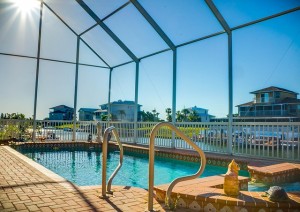
Do I have a leak in my pool, or is this just normal evaporation? If you have a pool in Central Florida, you’ve likely asked yourself this question. During the dry season (November to May), homeowners find themselves having to add more and more water to their pools due to the lower humidity and rain levels. While the constant addition of water may make you certain you have a leak, the dropping water level most likely is caused by evaporation.
Evaporation rates
It is not uncommon to lose up to 1/4 of an inch of water per day, on average, during the dry season. That adds up to be over 1.5 inches in a week! The main factors that influence the rate of evaporation are exposure, temperature and humidity.
Exposure
If your pool is located on the south side of your home, you will experience a higher evaporation rate due to the full-day sun exposure. Pools located in a windy area will lose more water, as well. Screen enclosures help to curb evaporation.
Temperature
The temperature swings during our dry season tend to increase evaporation. As we experience warm days and cooler evenings, the water in your pool evaporates faster.
Humidity
Low rainfall and humidity rates during the dry season also impact evaporation rates. When the air is humid, less water is absorbed from your pool. During dryer months, the evaporation rate is higher.
Measure your evaporation rate
Fill your pool to a normal level. Be sure not to over fill it. Make a pencil mark in the skimmer where your normal water level is. Run your pool pump and solar systems normally. If after one week you find that the water level has dropped more than 2 inches, you may have a leak. If it’s less than that, your water loss is likely due to use and evaporation.


